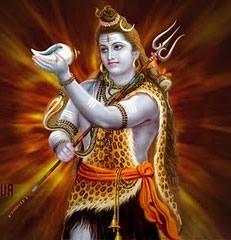 |
Essence Of
Linga Purana
|
| 3 Ashtanga Yoga-the Significant Means of Shiva Tatwa | |
To control the activities or goings on in the mind is Yoga. The Ashtanga or Eight-Limbed Yoga comprises of Yama- Niyama- Aasana- Pranaayama- Pratyahara-Dharana-Dhyana-Samadhi. Yama is denoted by good behaviour comprising Ahimsa (Non-Violence), Satya (Truth), Asteya (stealing), Brahmacharya (avoidance of sex) and Aparigraha or Excessive acquisition. Basic Niyamas is in fact an extension of Yama: To refrain from hurting or torturing co-Beings physically or mentally is Ahimsa; to convey whatever is seen, heard, and believed is Satya unless it does not hurt any body is known as Satya; to desist stealing of other’s property by deed, thought or otherwise is called Asteya; to negate from relationship with another female or in respect of a female wih another male, excepting the wedded woman or man as the case may be and this should be observed by vision, thought or deed is called Brahmacharya or celibacy; and to abstain from excessive acquisition of materials far and above one’s needs in the short run of time is stated to be Aparigraha. Besides the above General Principles, Niyamas also involve the specific deeds viz. Shoucha or Physical Cleanliness,Yagna-Tapa or meditation, Daana or charity, Swadhyaya or Memorising or Reciting the Scriptures, Indriya Nigraha or Control of Physical Limbs, Vratas like Chandrayana as also or to perform formal worship directed to specific Devatas and purposes,, Upavaasa or Fasting, Snaana or Formal Bathing besides Tirtha Seva and ‘Aniccha’or General Disinterestedness and abstinence; these are the Ten Niyamas. The next component of the Ashtanga Yoga denotes as Aasana which not only includes the right posture of formal seating like of Padmasana followed by ‘Bahyatantara Shuchi’ or external and internal cleanliness, Shiva Puja starting from Brahmanas, Agni, Varuna with other Devas climaxing with Parama Shiva. Included in the Aaasana are Japa, Swadhyaya, and Tapas etc; Japa should be of Panchakshari viz. Om Namassivaya Mantra and Swadhyaya is of Omkara and of Vedas and other Scriptures. Japa and Swadhyaaya are of three kinds: Vaachaka, Maanasika and Upaamsaka (Oral, mind-borne and Upaamshak or as guided by Guru). The next step is Pranayama or to practise interruptions of Prana or life-air or merely stated as the breathing processes of ‘Manda’ or mild, ‘Madhyama’ or medium and ‘Uttamaa’ or the best of variations; these interruptions comprise twelve units each of ‘Uchhvaasa’ or inhaling and ‘Nishvasa’ or exaling in the mild category, while these two holdings of breath would be for twenty four units in either case in respect of medium category and thirty units in either case in the best category. ‘Yogaabhyaas’ or the practice of Yoga besides providing happiness and peace of mind would cure several physical weaknesses to rectify respiratory and digestive imbalances, bring about shine of body and mind, cleanse up blood and its circulation and sharpness of thinking. Yoga unifies and balances of the ten kinds of ‘Vaayus’ or Airs in the human system viz. Praana-Apaana-Samaana- Udaana-Vyaana-Naaga-Kurma-Kukara-Devadutta and Dhananjaya. The air that enables vital functions of the human body, respiration and general activity is Praana; the air that is generated by the food intake down in the digestive process is Apana; the air that controls the involuntary movements of the body, circulation of blood,and flow of sweat from glands to skin and creating diseases is Vyaana; the air that controls the bubbling in the ‘marmaavaya’or the secret part is Udaana; the Equalising air balancing the body parts and stimulating digestive fluid is called Samaana; Udgaar (dakaar) is the wind called Naga; the wind enabling ‘Unmeelana’ or of the opening of eyes is Kurma; Kakara Vayu creates hunger, Devadatta created yawning and Dhananjaya Vayu creates high-pitch sounds and also remains with the body for a while even after death. Thus four kinds of Siddhis viz. Shanti, Prashanti, Deepti and Prasada are achieved by the Yoga. Pranaayama also achieves the generation of Tatwas viz. Vivaswara, Mahaan, Mana, Brahma, Smriti, Khyati, Ishwar, Mati and Buddhi. Pratyahara demolishes sins; Dharana facilitates the holding up of the crucial state of balance; Dhyana or meditation of Ishwara bestows the devastation of poisons like Vishayas or worldly matters; Samadhi leads to Prajna or Self-Consciousness. Thus Yoga aided by ‘Asana’ leads to the dynamic circle of Praanayama-Pratyahara-Dharana-Dhyana culminating in Samadhi. In fact a Maha Yogi is stated to possess sixty four kinds of Paisachika, Parthiva, Raakshasa, Yaaksha, Gaandharva, Aindra, Vyomatmika, Praajaapatya, Brahmaadi Siddhis but he should discard all such powers in the quest of Shivatwa. Such Siddhis range from assuming any type of Swarupa of fatness, slimnes, childhood, youth, old age, man, woman, any specie of a bird-animal-reptile, mountain, water body and so on; ability to lift mountains, drink up an ocean, flying on sky, passing through a needle’s eye and endless such miracles. [The normal Siddhis are Anima (miniaturising), Mahima ( Maximising), Prakamya (Visioning and Hearing), Isatwa (Rulership), Vasitwa (Self Control), Kama Vasitwa (ability to fulfill desires), Doora Shravana and Doora Darshana or distant vision and hearing, Parakaya Pravesha or ability to enter other’s bodies; ‘Devaanaam Saha kreedanam’ or playing with Devas, Yatha Sankalpa Samsiddhi or instant fulfillment of desires,Triloka Jnaana or knowledge of the happenings of Three Lokas; Control of heat and cold, Paraajaya or invincibility and so on.] Depending on the intensity of the success of the Yoga practice and the powers attained by way of controlling the Jnanendriyas and Tatwas, a Yogi could perform impossibilities but frittering the Siddhis so gained would negate the capacity to accomplish Shivatwa. | |
 Prev:‘Linga’ and ‘Alinga Rupaas’ and Primary Creation Prev:‘Linga’ and ‘Alinga Rupaas’ and Primary Creation | |
 Next:‘Linga’ and ‘Alinga Rupaas’ and Primary Creation
Next:‘Linga’ and ‘Alinga Rupaas’ and Primary Creation